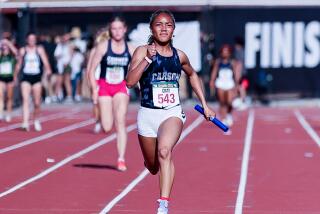Campbell Proves That He Can Fly
- Share via
Tonie Campbell showed up at Birmingham High’s Tom Bradley Stadium on Wednesday night with plane ticket in hand.
The Olympic hurdler didn’t have to be there. He could have gone straight to Los Angeles International Airport to depart for Baton Rouge, La., and the National Sports Festival, the destination of his air pass.
First, however, Campbell had some proving to do.
In no particular order, he wanted to prove wrong the doctors who said he would never run again after tearing up a knee April 12 in a meet at Port of Spain, Trinidad. He wanted to prove to himself that he could regain his world-class form.
And, he wanted to prove which hurdler deserved to represent the West at the Sports Festival.
To do so, Campbell met Milan Stewart, himself an Olympic Trials finalist, at the All-Comers Track and Field Meet at Birmingham.
“We had a gentlemen’s agreement that whoever won the race would go to the Sports Festival,” Campbell said. “I have the ticket with me, and was prepared to turn it over to Milan if I’d lost.”
No need. Campbell, in only his second competition since returning from the injury, won the 110-meter high hurdles with a meet-record time of 13.7. Stewart was right behind at 13.84.
For Campbell, the high-stakes victory in the low-key event was a sign of progress. It was his first sub-14.0 time since the injury, and it came against a good opponent.
Best of all, he felt no pain.
“Not too bad for a 10-minute warm-up,” said Campbell after running in a 4 x 100-meter relay. “This is my second workout today, and I’ve only been able to sprint train for two weeks.
“I feel great. I’m standing here feeling no pain.”
Campbell paused for a second, then amended his statement.
“Actually, the only pain I’m feeling is that of getting in shape,” he said.
There was a time when Campbell doubted if he’d feel that pain again. Substituting for an ill Edwin Moses in the intermediate hurdles at the Trinidad meet, he caught his toe on the eighth hurdle, twisted in mid-air and injured the posterior cruciate ligament and lateral meniscus cartilage in his right leg.
Surgery followed two weeks later, followed by speculation from Campbell’s physicians that his track career was over.
If things had gone as expected for Campbell in the 1984 Summer Olympic Games, he might have walked away from the sport right then.
But after failing to win a medal, Campbell wasn’t ready to quit.
“The injury shocked me back to reality,” he said. “Before the Olympics, I had planned to quit after they were over. But I didn’t want to be cheated out of a graceful retirement. I wanted to go out on my own terms.
“I want to be a medical miracle.”
Wednesday night, he was almost that. Not quite back to his Olympic form (13.23 is his personal best time), Campbell was relieved just to be back.
“I’m here to get my head together again,” Campbell said. “After the injury, I was scared. Track and field has always been my most intense love, and to have to give it up on the injury note scared me.
“Today, I proved to everybody that I would run again and that I could run again.”
And he got to keep his plane ticket.
Campbell wasn’t the only Olympian at Birmingham on Wednesday. He was joined by a man who could have been in Europe participating in some obscure international track meets.
Yet there was high jumper Dwight Stones helping assemble a makeshift pit on the all-weather track.
There was nothing makeshift about Stones’ performance, however. Battling dim light and getting little rest between jumps because of a four-man field, Stones cleared 7-2 3/4 before missing on his final three jumps at 7-4 1/2.
More to Read
Go beyond the scoreboard
Get the latest on L.A.'s teams in the daily Sports Report newsletter.
You may occasionally receive promotional content from the Los Angeles Times.






